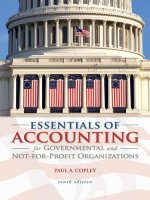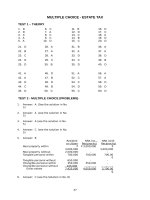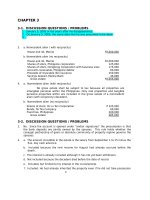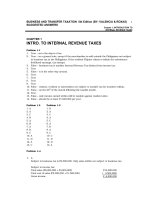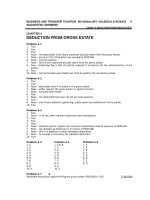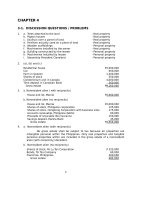Contract drafting and negotiation for entrepreneurs and business professionals by paul a swegle
Bạn đang xem bản rút gọn của tài liệu. Xem và tải ngay bản đầy đủ của tài liệu tại đây (779.25 KB, 166 trang )
Thisbookisintendedtoprovideaccurateandauthoritativeinformation,butitis
soldwiththeunderstandingthatneithertheauthornorthepublisherisengaged
inprovidinglegaladviceorrepresentation.Iflegaladviceisrequiredregarding
specificfactsandcircumstances,theservicesofaqualifiedlawyerlicensedin
theappropriatejurisdictionshouldberetained.
âBusinessLawSeminarGroup,LLC2018.Allrightsreserved.
Nocopyrightisclaimedorassertedintheexcerptsofanycourtopinionsquoted
withinthiswork.Permissiontocopymaterialexceedingfairuse,17U.S.C.Đ
107,maybelicensedfromBusinessLawSeminarGroup,LLCat
LibraryofCongressControlNumber:2018942264
eBookASIN#-B07DM3J7B2
PaperbackISBN#-978-0-692-13830-4
ThisbookisdedicatedtomywifeSerenaandtomychildrenMatthewand
Stephanie.
ThankyouSerena,KurtZumdieck,JimSwegleandJohannaFuhrfortheunique
perspectiveseachofyouprovidedinreviewingandeditingmymanuscript.
Contents
Introduction
TheUnforgivingLawofContracts
HiddenHazards
LeveragingtheBusinessMindset
Perspective
Caveats
ChapterOne
CONTRACTLAW
ContractsasPrivateLaw
ContractFormation
MutualAssent
Authority
Consideration
OfferandAcceptance
DefensestoContractFormation
TheParolEvidenceRule
ExceptionstotheParolEvidenceRule
PromiseversusCondition
RulesofInterpretation
ImpliedCovenantofGoodFaithandFairDealing
Waiver,Modification
LettersofIntentandOralContracts
Breach,DamagesandRemedies
SummaryofContractLaw
ChapterTwo
COMMONMISTAKES
PerformancebeforeAgreement
FailingtoShopandCompare
InadequateDescriptionsofPerformanceObligations
WeakorNonexistentRemedies
PoorVettingofVendors,SuppliersandOthers
BlindlyAccepting“StandardContracts”
DurationTooLongorTooShort
PoorDocumentChangeTrackingandProofing
ChapterThree
NEGOTIATION
NegotiationTraining
DemeanorandAttitude
BodyLanguage
GettheOtherSideTalking
NegotiatingChips
DoNotNegotiateAgainstYourself
ConflictsofInterests
ProtectionofConfidentialInformation
GetTechnicalDocumentsandSpecificationsEarly
ChapterFour
DRAFTING
Clarity
DraftingRedFlags
Completeness
TechnicalDetails
UnderstandtheDeal
ActiveAnalysis
DraftMarking
InitialDraftIssues
HandwrittenChangesinFinalDrafts
ChapterFive
COMMONCONTRACTTERMS
Introduction
Title/Caption
OpeningParagraph/Recitals/Background
Recitalsor“Whereas”Clauses
Definitions
ObligationsoftheParties/Services
Fees/Pricing/FeesandPayments
IntellectualProperty/ProprietaryRights
Confidentiality/ConfidentialInformation
TermandTermination
EffectsofTermination
RemediesforBreach
RepresentationsandWarranties
Disclaimers/WarrantyDisclaimer
Limitations/LimitationofLiability
Indemnification
Insurance
ModificationandWaiver
Arbitration
Severability
Assignment
GoverningLaw,VenueandJurisdiction
Notices
ForceMajeure
EntireAgreement/Integration/Merger
LegalExpenses/LegalFees
Survival
Authority
Counterparts
SignatureBlock
ChapterSix
IMPLEMENTATION
SigningandFiling
Tracking
ContractManagementTechnology
Performance
DealEvolution
ChapterSeven
AMENDMENTSANDADDENDUMS
ChangingCircumstances
Addendums
Amendments-ContractSurgery
TacticalConsiderations
ConsistencyandGoodContractManagement
TooManyAmendments
ChapterEight
DISPUTERESOLUTION
DisputeAvoidance
BeRight
KeepEmotionsinCheck
DisputesareJustDifficultNegotiations
InitialAssessment
CatsinTrees
SandTraps
CodeRed–ZeroSumDisputes
UseofCounsel
Introduction
TheUnforgivingLawofContracts
In 1990, a massive floating bridge between Seattle and Mercer Island used
by thousands of cars every day sank in a storm while being refurbished. The
state’sagreementwiththecontractorwasapparentlyunclearonwhoshouldpay
forthesinking.Afteryearsoflitigation,thecontractor’sinsurersagreedtopay
$20millionwithoutadmittingresponsibility.
In 2013, Bertha, the largest and most expensive drill ever built, overheated
and ground to a halt under Seattle. Again it was not clear who should pay the
resultingrepairanddelaycosts,estimatedatonepointtobe$480million.
In 2006, the Canadian Radio-television Telecommunications Commission
weighed in on a very expensive punctuation dispute between Rogers Cable
Communications and Aliant Telecom. The CRTC ruled that Aliant could
terminate an agreement between the two parties much sooner than Rogers
believedwaspermittedunderthefollowingpassage:
[theStructureSupportAgreement]shall...continueinforceforaperiodof
five(5)yearsfrom the dateitismade,andthereafterforsuccessivefive
(5) year terms, unless and until terminated by one year prior notice in
writingbyeitherparty.
RogershadwrittentheabovepassageintendingthatAliantwouldnotbeable
toterminatetheagreementuntilaftertheinitialfiveyearterm.
Initsruling,theCRTCfoundthatplacementofthecommabeforethephrase
“unless and until terminated by one year notice in writing by either party”
permitted “termination of the SSA at any time, without cause, upon one year's
writtennotice….”
TheCRTC’srulingallowedAlianttoterminateyearsearlierthanRogershad
expected, apparently costing Rogers $2.4 million, all because of an errant
comma.
Obviously, even professional contract negotiators and drafters miss
importantissues.Misstepslikethesehappenbothingovernmentandinbusiness.
In business, cost constraints can limit access to competent legal counsel.
Sometimesinhighpressurebusinessenvironmentsthereisalsopressuretoact
quicklyandapologizelater.
Butcommercialagreementsareunforgiving.Noapologywillraiseasunken
bridge, unwind an agreement that unexpectedly transfers your intellectual
property,orotherwisere-writeadealthatcallsforthewronggoodsorservices
orthatspawnslegalorregulatoryliabilities.
HiddenHazards
Unfortunately, many contract drafting traps are invisible to non-lawyers. It
takesmuchlessskilltocritiquewhatisinanagreementthanitdoestoidentify
andcorrectwhatisnot–thingslikeremediesforbreach,rightsoftermination,
intellectualpropertyprotections,orcorrectdescriptionsofwhattheotherpartyis
supposedtodo.
Asaresult,entrepreneursandotherbusinesspersonscanoverestimatetheir
abilitytocompetentlynegotiatecommercialagreementswithoutlegalassistance.
Sometimesthisleadstopainfulsurprises.
LeveragingtheBusinessMindset
On the other hand, entrepreneurs and other business persons with strong
contract drafting and negotiation skills can be the most valuable individuals at
the table. They often understand the economics and business logic of
commercial relationships better than attorneys, and they usually take a more
pragmaticandcreativeapproachtofindingthecompromisesneededtogetdeals
done.Andunlikecounsel,whobringprofessional“malpractice”concernstoany
project, sophisticated and well-informed business persons can be better
positioned to weigh calculated risks regarding novel and complex commercial
relationships.
Perspective
Most commercial agreements involve one party purchasing some type of
good or service from another party, or a combination of goods and services.
Thus, one party is often considered a “buyer,” “customer” or “client,” and the
othera“seller,”“vendor,”“provider”or“supplier.”Forsimplicity,we’llthinkin
termsofbuyersandsellers.
Manyofthetopicsinthisbookarediscussedlargelyfromtheperspectiveof
thebuyer.Onereasonforthisisbrevity.Thereareseveralothersthough.
First,sellersoftenhavestandardcontractsthattheyroutinelypresentto
buyers. In many cases, these standard contracts were drafted by the
seller’s lawyer months or years earlier and were loaded up with terms,
both relevant and irrelevant, that favor the seller. Consequently, it is
often the buyer who is faced with reviewing a new and potentially
confusingagreement.
Second, the buyer is often at an informational disadvantage. This is
because sellers generally know more than their buyers about the goods
or services being sold and about how to protect their interests in
transactionsinvolvingthosegoodsorservices.
Third, sellers might be slightly more apt to breach their commitments
than buyers, given the generally more significant performance
challenges facing sellers – e.g., producing and transporting goods on
time, developing software on time, competently providing specialized
services,andsoforth.
In most contract situations, therefore, it is the buyer who needs more
coachingonhowtoprotecthisorherinterests.Thatsaid,whererelevant,issues
ofparticularimportancefromtheseller’sperspectivearealsoaddressed–e.g.,
developing solid but workable template agreements, avoiding over-promising,
and limiting downside risk through warranty and liability limitation clauses,
amongothers.
Keepperspectiveinmindandconsiderbothsidesofeachissue.Theability
toevaluatetheotherparty’sconcernsisanadvantageincontractnegotiations,as
discussedinChapterThree,Negotiation.
Caveats
Nothinginthisbookislegaladvice.Legaladviceisalwaysbasedonspecific
factsandrequiresanattorney-clientrelationship.
Also, this book also does not address the Uniform Commercial Code
(“UCC”) in detail. Article 2 of the UCC, adopted in varying forms by every
state, applies to all contracts for “goods.” Goods are defined as any tangible
thingthatismoveable.Readerswhoregularlybuyorsell“goods”shouldwork
withcounseltoensureUCCissuesarecovered.
ChapterOne
CONTRACTLAW
ContractsasPrivateLaw
Contracts create “private law” between two parties. Courts enforce valid
contracts in order to provide predictability in private relationships and to
facilitate commerce. Enforceability is a double-edged sword though, rarely
distinguishingbetweengooddealsandbad.
Throughout this book, there are references to “case law.” Case law, also
called“precedent,”and“commonlaw,”meansthegeneralbodyoflawcreated
bystateandfederalcourtsofappeals.
ContractFormation
A contract is formed when there is “mutual assent” (also known as a
"meeting of the minds") between two parties to enter into an agreement
supported by “consideration” (money or something else given in exchange).
Issuesof“contractformation”areoftenrelevanttoapartyseekingtogetoutof
anagreementbyarguingthatacontractneveroccurred.Wewillconsiderwhatit
takes to form a contract, and then several common "defenses" to contract
formation,i.e.,argumentsthatnocontractwaseverformed.Additionaldefenses
toformationappearbelowinthediscussionoftheParolEvidenceRule.
MutualAssent
Mutualassentmeansthattwopartiesovertheageof“majority”(18years)
and of sound mind have voluntarily agreed to enter into an agreement under
which each will do or provide certain things. Where fraud or duress is used to
convinceaparty(i.e.,gunpoint)toenterintoanagreement,therequirementof
voluntaryassentisabsentandthecontractcanbevoided.
Interestingly,mostcontractsinvolvingminorscanbevoided,butminorsare
generally not permitted to “disaffirm” contracts involving “necessities” like
food,clothingandshelter.
Mutual assent can also be undermined by mutual mistake about a material
factorassumption,asdiscussedbelowunderParolEvidenceRule.
Authority
Another concept falling under “assent” is “authority” – the question of
whethertheindividualsigningforapartyisactuallyauthorizedtoenterintoit
onbehalfofthatparty.Or,alternatively,hastheotherpartyheldthatpersonout
ashavingsuchauthority?
This should not be a concern where you are dealing directly with the
president, chief financial officer, general counsel or sole proprietor of a
company.Butanunusuallygenerousdealsignedbyasalespersonorbusiness
development vice president, for example, might later be disputed as
“unauthorized.”
For any contract involving substantial risks, commitments or monetary
value,considerdemandingproofofactualauthority.Inthecaseofcorporations
or partnerships, this may involve requiring the other side to produce board
resolutions, partnership operating agreements, or delegations of authority
outliningthesigningauthoritiesofpersonsincertainpositions.
Consideration
Eachpartyhastoagreetodoorgivesomethingofvalueinexchangeforthe
performance of the other party. If one party is not obligated to do or give
anything of value, or their performance is otherwise voluntary or “illusory,”
thereisnoenforceablecontractunderlawandeitherpartymaybackout.
Even where the value of the consideration from one party is substantially
greaterthanthatfromtheother,courtsgenerallydonotintervenetoinvalidate
such agreements. That said, contracts citing “$1” or “love and affection” in
exchange for goods or services of measurably higher value might not survive
attackinsomestates.Thecaselawvariesfromonejurisdictiontoanother.
Courtsinmoststateswillnotsetasideacontractunlessthe“inadequacy”of
oneparty’sconsideration“issogrossastobeconclusiveevidenceoffraudand
astoshocktheconscienceofthecourt.”Caseswhereconsiderationisfoundto
bewantingalsousuallyinvolveothergroundsforinvalidation,suchasfraudor
duress.
Itshouldbeobviousfromtheabovethatgiftswithoutconsiderationfromthe
otherpartycannotbeenforcedundercontractlaw.
Companies that fail to get proper intellectual property assignments at the
timeofhiringemployeesorcontractorsoftenstumbleonthisconceptwhenthey
later try to get departed employees and independent contractors to sign
intellectualpropertyassignmentformswithoutofferinganyconsideration.Any
suchformssignedwithoutsomeformofcompensationaresubjecttobeinglater
disaffirmed by the former employee or contractor as unenforceable gifts. A
document that would have had no price tag if signed at the beginning of an
individual’s employment can become much more costly when that employee
knows that his or her signature is necessary to close a major financing or
acquisitioninvolvingtheformeremployer.
OfferandAcceptance
Although there have been cases involving questions of whether “offer and
acceptance” to enter into an agreement truly occurred, such problems are rare
and can be easily avoided. Use caution in making a proposal that might be
viewedbytheotherpartyasafirmoffertoenterintoacontract.Ifyouproposea
sufficiently detailed arrangement, even orally, in a manner that could be
reasonablyinterpretedasanoffertocontract,acceptancebytheotherpartycan
resultinabindingcontract–oratleastadisputetothateffect.
To avoid such issues, lawyers often stamp draft agreements with “DRAFT
PROPOSALFORDISCUSSIONPURPOSESONLY”orsimilarlanguage.
OfferTermination
Anofferthatisdetailedanddefiniteenoughtoresultinacontractifaccepted
issometimescalleda“firmoffer.”Onceafirmofferhasbeenmade,itremains
openuntilanyofthefollowingevents:
Rejection.Ifanoffereerejectsanoffer,ormakesacounterofferaltering
importantterms,theofferisnolongeropen.
Revocation.Theofferorcanrevokeorretractanofferatanytimebefore
itisaccepted,eveniftheofferorsaidorwrotethatitwouldbeopenfora
longerperiod.Suddenrevocationofanoutstandingoffermaystrikethe
offereeasunfair,butitisperfectlylegal.Sittingonanoffercarriesrisk
ofrevocationwithoutwarning.Offereescangetaroundthisconcernby
paying the offeror to keep the offer open. This is a separate contract
itself,calledan“option”–i.e.,acontractallowingtheoffereetomakea
decisionaboutsomethinglater.Landlords,forexample,areoftenwilling
toholdaspaceforafeewhileatenanttakesanadditionalweekortwo
toconsideralternatives,givingthetenantand“option”onthespace.
Lapse. Some offers lapse at a stated time, and all offers are subject to
terminationaftera“reasonabletime”dependingonthecircumstances.
Death.Thedeathorinsanityoftheofferorwillterminateanoffer,aswill
thedestructionofthesubjectmatteroftheoffer.
DefensestoContractFormation
Illegality
A contract must not require one or both parties to do something prohibited
bylaw.Ifitdoes,allorpartofthecontractwillbeunenforceable,dependingon
thefacts.
A contract to traffic in endangered species, for example, would be
unenforceablebetweentheparties,allowingeitherpartytobackout.
The same would be true of a contract to commit murder, fraud, or even a
“tortiousact”onathirdparty,includingtrespass,misrepresentation,defamation
orcontractualinterference.Interestingly,amountspaidtowardtheperformance
ofanillegalcontractgenerallycannotberecoveredinacivillawsuit.
On the other hand, if a less important or secondary part of one party’s
performancerequiresanillegalact,forexampleimpropercollectionorsharing
ofcustomerdata,itbecomeslessclearthateitherpartycouldsimplywalkaway
from the contract on the basis of illegality. A court would look at whether the
contractcontaineda“severability”clause(i.e.,"Ifanypartofthisagreementis
found unenforceable, it shall be deemed struck, without invalidating the
remainderoftheAgreement")andwhethertheillegalrequirementinthecontract
cansimplybestruckwithoutunderminingtheoverallintentoftheparties.
SeverabilityclausesarediscussedfurtherinChapterFive,CommonContract
Terms.
AgainstPublicPolicy
Evenabsentaspecificruleorstatute,acontractoraspecificprovisionina
contract may be found by a court to be “against public policy.” Depending on
thecircumstances,acourtmayinvalidateallorpartoftheagreementorrefuseto
providearemedy forbreachoftheagreement.Courtsvaryinhowtheydefine
what is “against public policy,” but the following statement from a New York
courtin1991istypical:
“Anagreementisagainstpublicpolicyifitisinjurioustotheinterestsof
thepublic,contravenessomeestablishedinterestofsociety,violatessome
public statute, is against good morals, tends to interfere with the public
welfare or safety, or is at war with the interests of society or in conflict
withthemoralsofthetime.”
Publicpolicyissuesarisewherethereisanallegedpublicinterestorimpact
beyond the narrow interests of two private parties. Not surprisingly, these
concerns arise more often when a government, or “public,” entity is party to a
contract. For example, provisions in public works contracts requiring a
municipalitytoindemnify(defendincourt,payfines,judgments,andsoforth)a
contractor for the contractor’s own negligence (failure to use due care) have
beeninvalidatedas“againstpublicpolicy.”
Oncesuchanargumenthasprevailedwhereagovernmententityisinvolved,
it is possible for the precedent to be applied successfully between private
litigants.Thecaselawregardingprovisionsrequiringapartytobeindemnified
foritsowngrossnegligenceorwillfulmisconducthasfollowedthispattern.
As another example, public policy arguments have also been used to
invalidate “unreasonable post-employment restrictions” on the basis that those
restrictionsharmboththeformeremployeesandtheeconomy(apublicinterest)
that is deprived of their services. In general, courts have frowned upon and
invalidatedblanketprovisionsthatpreventaformeremployeefromworkingfor
others in an industry longer than six or twelve months, primarily due to the
financial impact on the employee, but also due to potential impacts on the
public, which might lose the individual’s economic contributions during the
restrictionperiod.
Unconscionability
Unconscionability is another concept courts use to re-write or nullify
contracts, particularly where a party in a superior bargaining position has used
thatpositiontoexact“unfair”terms.Notably,invalidationinasinglecasewitha
customer can invalidate the contract or offending provision as to all customers
coveredbythesamecontractorprovision.
In 2016, for example, the Delaware Court of Chancery found that a
defendant was improperly and unconscionably using an interest-only, nonamortizinginstallmentloantoevadeDelaware’sPaydayLoanLaw.
Andina2016Michigancase,aplaintiffprevailedonanunconscionability
claim to invalidate an account provision that permitted a bank to batch and
reordercustomers’transactionstomaximizeoverdraftcharges.
Unconscionability claims are very difficult to prove, particularly where
consumershaveotherchoicesinthemarket,butwinorlose,theyusuallycreate
publicityheadachesforcorporatedefendants.
As a preventative measure, any one-sided contract to be used in consumer
transactions by an experienced dealer or provider should be reviewed by a
competentlawyer.
The best way to forestall litigation and protect one-sided language from
invalidationistocallitoutincapitalizedlettersunderanunambiguouscaption
and to include language explaining why the provision is appropriate and
reasonableinthecontext.
TheParolEvidenceRule
A number of important contract law concepts are best explained and
understood in relation to the Parol Evidence Rule. The Parol Evidence Rule is
oneofmanyrulesofevidencethatdictatewhatfactsorotherevidencecanand
cannotbeintroducedinatrial.
Eventhoughnotdirectlyaruleofcontracts,theParolEvidenceRuleimpacts
how contracts are interpreted and enforced by courts. The word “parol” comes
fromaLatinwordmeaning“oral.”
Theruleessentiallysaysthat,whereawrittencontractisintendedtobethe
parties’ entire agreement, other evidence, either written or oral, cannot be
introducedtosaythatthepartiesintendedsomethingelse.Thegoaloftheruleis
toprovidecertaintyincontractualrelationships.
ExceptionstotheParolEvidenceRule
In a perfect world, all contracts would be drafted with precision and
foresight, clearly and comprehensively describing the parties’ intentions and
accountingfortheunexpected.Realitybeingwhatitis,noteverycontractmeets
thisstandard.Asaresult,courtshavecreatedanumberofimportantexceptions
to the prohibition against evidence “outside of the four corners” of a contract,
i.e.,notfoundwithinthecontractlanguageitself.
ThefollowingexceptionstotheParolEvidenceRuleareoftenimportantin
contractlitigation.Aswithotherconceptsofcontractlaw,understandingthemin
advancecanaidinpreventativedraftingtoavoiddisputesdowntheroad.
Ambiguity
Evenwhereacontractrecitesthatitcontainsthecompleteunderstandingof
thepartiesanddisclaimstheexistenceofanyotherwrittenororalagreementsor
understandings,theParolEvidenceRulewillallowapartytointroduceevidence
outside of the contract to resolve an “ambiguity.” An ambiguity is a term to
whichreasonablepersonsmightassigndifferentmeanings–i.e.does“200 red
pens”mean200penswithredinkor200penswithredexteriors?Totheextent
possible, contracts should be drafted to avoid ambiguities by assigning clear
definitionstoimportantterms,preciselydescribingtheobligationsofeachparty
andcarefullyavoidinggrammaticalandwordchoiceerrors.
Inpractice,contractsarerarelyfreefromallambiguity,and,inanydispute,
ambiguitiesareoftenamongthefirstpointsofattackofanygoodlawyer.
Interpretation
Parolevidencemayalsobepermittedbyacourtto“interpret”acontractin
order to determine the parties’ actual intent, but it will be permitted only to
explain missing terms, not to contradict terms clearly provided for in the
contract.The“RulesofInterpretation”discussionbelowgoesintomoredetailon
when and how courts decide whether parol evidence, also called “extrinsic”
evidence,shouldbeconsideredtobetterunderstandtheparties’intent.
Mistake
Parolevidencecanalsobeintroducedtoshowtheabsenceofmutualassent
necessary for the creation of a contract in the first place. To qualify under the
exceptionandtoinvalidateacontract,amistakemustbe“heldbybothparties”–
i.e., both parties were mistaken about a fact material to the formation of the
contract.
AcommonexamplecitedintextbooksiswherepartyAagreestopayparty
Bacertainamounttodrillawelltosupplyfreshwater.Afterdrillingattheplace
identifiedbyA,Bencountersimpenetrablerock20feetdown.Sincebothparties
weremistakenaboutthefeasibilityofdrillingthewell,acourtmightnullifythe
contractongroundsofmistake.
A mistake in business judgment or mistake of fact by one party, however,
willnotnullifyacontract.Forexample,ifonepartygetsagreatdealonarare
coinbecausetheotherpartydidnotknowitsvalue,heorshecannotlaterseekto
invalidate the transaction. That is not what is meant by the term mistake in
contractlaw.
Awarenessofapossible“mistake”issueduringanegotiationmightbeared
flagwarrantingguidancefromcounsel.
Fraud,Duress
Like mistake, proof that a party entered into a contract under duress or in
circumstancesinvolvingfraudbytheotherpartyispermittedasanexceptionto
the Parol Evidence Rule in order to show the absence of voluntary mutual
assent.
As one somewhat familiar example, a party stuck in a resort timeshare
contract that has not turned out to be what the timeshare company represented
might be able to invalidate the contract based on any documented fraudulent
statementsaboutthingssuchasthelikelihoodofpriceappreciation,whetherthe
timesharecontractwasfreelytransferable,oreventhedegreetowhichthetime
sharepurchaserwouldenjoybookingpriorityovernon–purchasingvacationers.
Similarly, an elderly person pressured into a timeshare contract following
hours of high pressure sales tactics, including actions that made it difficult for
the person to leave the sales presentation, might have a case for breaking the
agreementduetoclaimsofduress.
PromiseversusCondition
Underoldercaselaw,eachparty’sconsiderationinacontracttakestheform
ofapromise(s)orcondition(s).Thisdistinctionislessimportantundermodern
caselaw,butawarenessoftheissuehelpstohighlighttheneedfordetailingthe
consequencesofeitherparty’spotentialperformancefailures.
HereareexcerpteddefinitionsofthesetermsfromBlack’sLawDictionary:
Promise:Adeclaration,verbalorwritten,madebyonepersontoanother
foragoodorvaluableconsiderationinthenatureofacovenantbywhich
the promisor binds himself to do or forbear some act, and gives to the
promiseealegalrighttodemandandenforceafulfillment.
Condition: A future and uncertain event upon the happening of which is
madetodependtheexistenceofanobligation,orthatwhichsubordinates
theexistenceofliabilityunderacontracttoacertainfutureevent.
Failure by “party A” to perform on its promise(s) will always allow “party
B” to seek damages from party A, but may or may not enable party B to
withholditsperformance.
Absentclearlanguage,acourtwilltrytoascertainthe“intentoftheparties.”
Thisrequiresreadingthecontractasawholeand,ifnecessary,consideringany
evidenceavailabletoitunderexceptionstotheParolEvidenceRule.Thecourt
mayconcludethatthepromisenotperformedbypartyAdoesnotexcuseparty
B’sperformance,butmerelycreatesarightinpartyBtopursuedamages.
Undermoderncaselawinmostjurisdictions,however,ifpartyA’sbreachis
material, party B’s performance will be excused and B would also likely be
entitledtodamages.
When a contract clearly states that party A’s performance is a condition to
partyB’sobligationtoperform,thenpartyBwillbeexcusedfromperformingif
partyAfailstoperform.
Thiscancreatetimingquestions.WhatifpartyAperforms,butonlyafterthe
requiredtimeunderthecontract?OrwhatifpartyAperforms,butnotentirely,
orperfectly?Courtssometimesviewarightofterminationasadrasticremedy
andoftenlookforsomethinginthe“intentoftheparties”tosupportalessharsh
outcome.Therefore,ifpartyA’stimelyperformanceisindeedintendedtobea
condition to party B’s performance, party B should insist on clear language to
that effect, along with language specifically justifying that approach so a court
knowsitwasbothintendedandnegotiated.Thefollowingisanexampleofwhat
thatmightlooklike:
“In the event Party A fails to provide the Delivery Truck in like-new
condition by the Commencement Date, Party B shall be relieved of its
obligations to provide the Delivery Services for Party A, as the parties
acknowledgeandagreethatPartyBhasnocost-effectivealternativesfor
providing the Delivery Services and also that Party B will need to
promptlypursueotherbusinessopportunitiesintheeventofsuchfailure
byPartyA.”
Draftingperformanceobligations,remediesintheeventofaparty’sbreach,
andrightsandobligationsintheeventofcontractterminationarealldiscussed
furtherinChapterTwo,CommonMistakes,ChapterFour,Drafting,andChapter
Five,CommonContractTerms.
RulesofInterpretation
IntentoftheParties
Mostcontractdisputesinvolvequestionsofinterpretation.Disputescanarise
fromdifferentviewsofthesamelanguageordifferentideasonhowtodealwith
unanticipated gaps in the contract language. The goal of contract law is to
determinewhatthepartiesintendedatthetimetheyenteredintotheagreement.
Thisisdonefirstandforemostbyexaminingthecontractlanguage,andthen,as
necessary,thefactualcontext.
With respect to unforeseen developments, courts must decide what result
best reflects the intentions of the parties and produces an outcome that is
“reasonable.”Inwrestlingwithsuchquestions,courtshavedevelopedanumber
of “rules of interpretation,” sometimes also called “rules of construction.”
Knowing and applying the rules of interpretation in contract drafting can help
reduceuncertainty.
Drafting to minimize issues of interpretation is often challenging for nonlawyers. This is because of the inherent subtleties of written language and the
non-lawyer’s inexperience in dealing with contract disputes, litigation, judges,
juries and other aspects of law that are learned only by lawyering. With that
caveat,herearesomegenerallyacceptedrulesofinterpretation:
PlainMeaning.Wordsaregiventheirplainandnormalmeaning,except
wheretheusageofaparticularwordhasvariedthatmeaning.
TechnicalWords.Technicalwords,orwordscustomarytoaparticular
industry,willbegiventheirtechnicalorspecialmeaningswhenusedin
thatcontext.
IntentionsoftheParties.Wordswillbegiventhemeaningthatseems
tobestreflecttheintentionsoftheparties.
Consistency with General Purposes. Every part of a contract will be
readinamannerthatisconsistentwithitsgeneralpurposes.
Surrounding Circumstances. As described above under the Parol
Evidence Rule, the circumstances surrounding a contract’s negotiation
maysometimesbeshowntoaidinitsinterpretation.
NarroworRestrictedMeanings.Specificusesofatermorphraseina
contractmayimposethesamenarroworrestrictedmeaninguponmore
generalusesofthesametermorphraseinacontract.
Lists. Depending on the context and specific language used, detailed
lists of similar items can be read to exclude items that are not similar.
Conversely,agenerallistcanbereadtoincludemorethanthoselisted.
Reasonableness.Wherepossible,acontractwillbeinterpretedtorender
itreasonableratherthanunreasonable.
Non-Drafting Party Bias. Given competing meanings, a court will
generallyfavortheoneurgedbythenon-draftingparty.
Courtsusetheserulestostandardizehowlanguagewillbeinterpretedinthe
eventofadispute.Thegoalisalwaystodetermineandgiveeffecttothe“intent
oftheparties.”
Firstandforemostthen,partiestoanagreementshouldattempttosummarize
theirintentions.AsdiscussedbelowinChapterFive,CommonContractTerms,
theintentofthepartiescanbeexplainedinthe“recitals”or“whereas”clausesat
thetopoftheagreement.
Otherdraftingtipsforclarifyingtheintentoftheparties:
Avoid words, clauses, or sentences that may have more than one
meaning.Thisincludesbeingsensitivetothedifferentoutcomesthatthe
useof“and”canhavewhen“or”isthebetterchoiceandvisaversa.
Place adverbs, adjectives, and other modifiers with precision and use
appropriategrammaticaltechniquesandpunctuationtoachieveclarity.
Lastly, use terms consistently. Contract drafting is not the same as
creative writing – avoid using a variety of terms to express the same
meanings.Contractsneedtobeclear,notinteresting.
ImpliedCovenantofGoodFaithandFairDealing
As noted above under Rules of Interpretation, between two competing
interpretations of a contract provision, courts will often favor the one that
renderstheprovisionreasonableratherthanunreasonable.
Similarly, courts in many jurisdictions in the United States recognize an
impliedcovenantofgoodfaithandfairdealingincontractualrelationships.This
implied covenant generally requires the parties to act honestly and fairly with
each other. Fraudulent, evasive, oppressive, dishonest or otherwise unfair
conductbyonepartyagainstanotherhasbeendeemedtoviolatethecovenant.
The implied covenant of good faith is in tension, though, with two
fundamentaltenetsofcontractlaw:(1)thefreedomofpartiestocontractasthey
wish,and(2)therightofeachpartytoactinitsownbestcommercialinterest.
Asaresult,whilecommonlyfollowedinsomeformoranotherinmoststates,it
isnotrecognizedineverycountry,includingEngland,forexample.
AsdiscussedinmoredetailinChapter8,DisputeResolution,apartythatcan
pointtoviolationsofspecificcontractualprovisionssupportedbyprovablefacts
usuallyhastheupperhandinadispute.Barringsuchfacts,however,ifoneparty
toanagreementhasactedinamorallyreprehensiblemannerthatpreventedthe
other party from receiving “the fruits of its bargain” or that “frustrates the
overarchingpurposeoftheagreement,”somestates,likeCalifornia,mayallowa
claimanddamagesbasedonabreachoftheimpliedcovenantofgoodfaith.
Herearesomeexampleswherethecovenantmightbesuccessfullyinvoked:
Intentionallywithholdingcriticalinformationfromtheotherparty.
Intentionallyperformingpoorlyinordertoextractconcessionsfromthe
other party, particularly if done by a party in a much more powerful
position.
Failingtoprovidereasonablecooperationnecessaryfortheotherparty’s
performanceorotherwiseinterferingwithorthwartingtheotherparty’s
performance.
Seekingtoterminateanagreementbasedonfalseorhighlyexaggerated
claimsofbreachbytheotherparty.
Willfulconductintendedtocausecommercialharmtotheotherparty.
In particularly egregious cases involving fraud or extremely harmful
conduct, some jurisdictions might even allow for punitive damages and
attorneys’ fees in a “bad faith” case. But such awards are highly disfavored
undercontractlaw,exceptintheuniqueareaofinsurancecontracts,andshould
notbeaprimaryfactorindecidingwhetherornottolitigate.
TortClaims
As discussed in Chapter Eight, Dispute Resolution, punitive damages and
attorneys’ fees, generally disallowed under contract law, can be awarded in
“tort”claims–i.e.,wrongfulconductthatcausesharmtoothers.Tortsallegedin
businessinclude,amongothers,fraud,tortiousinterferencewithacontract,and
theftoftradesecrets.
Whilecourtsoftenrejectattemptstoconvertnegligentcontractperformance
claimsintotortclaims,ortocombinethetwo,courtshaveacceptedtortclaims
incontractscaseswherethereareclearinjuriesfrombreachesofanydutiesthat
